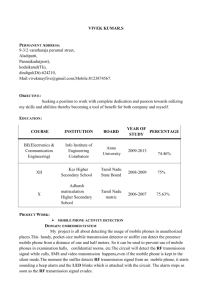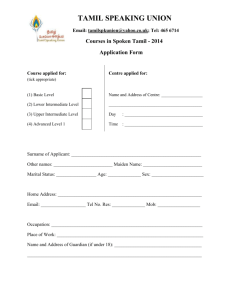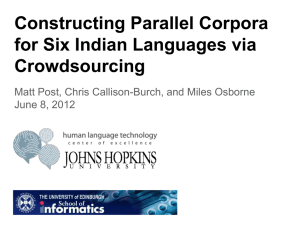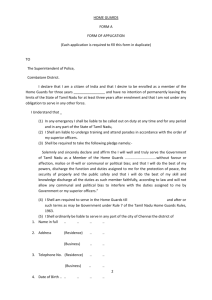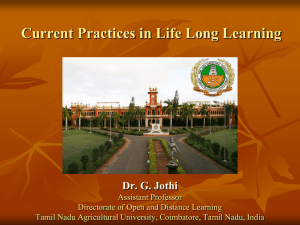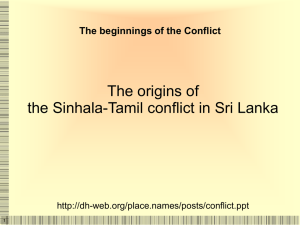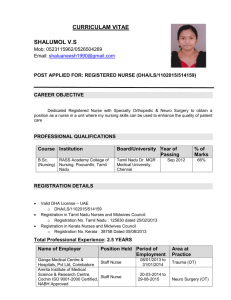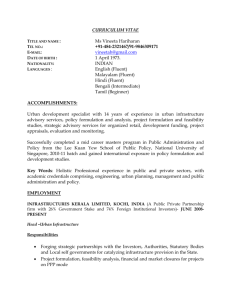Tamil Liquids, Revisited - School of Arts & Sciences
advertisement
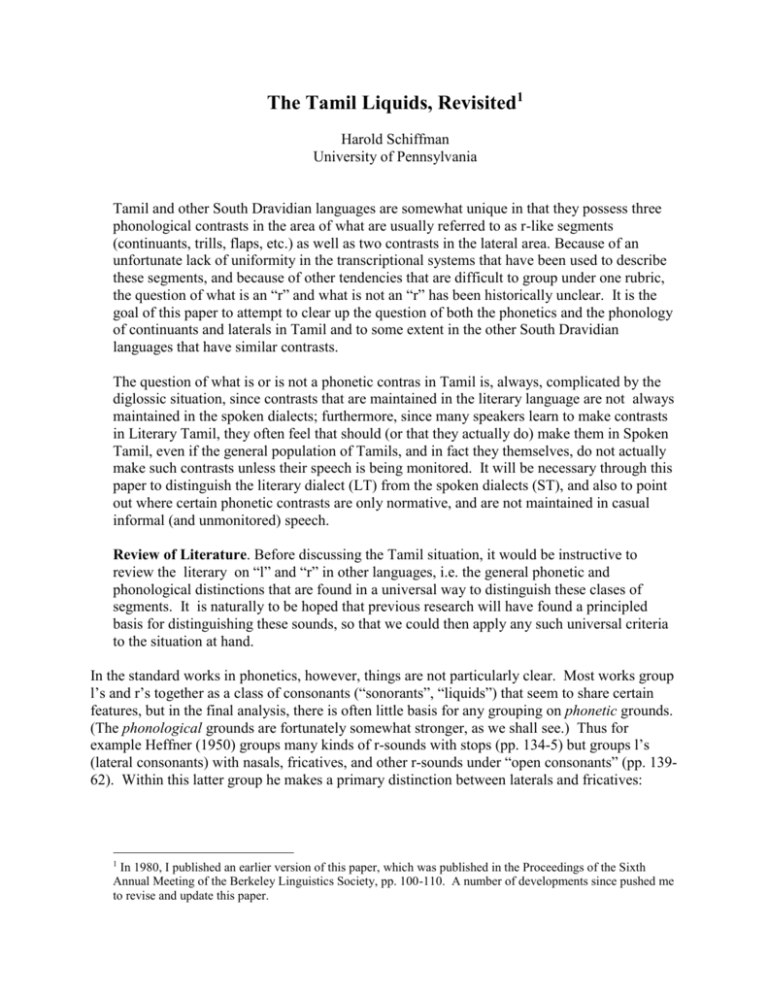
The Tamil Liquids, Revisited1 Harold Schiffman University of Pennsylvania Tamil and other South Dravidian languages are somewhat unique in that they possess three phonological contrasts in the area of what are usually referred to as r-like segments (continuants, trills, flaps, etc.) as well as two contrasts in the lateral area. Because of an unfortunate lack of uniformity in the transcriptional systems that have been used to describe these segments, and because of other tendencies that are difficult to group under one rubric, the question of what is an “r” and what is not an “r” has been historically unclear. It is the goal of this paper to attempt to clear up the question of both the phonetics and the phonology of continuants and laterals in Tamil and to some extent in the other South Dravidian languages that have similar contrasts. The question of what is or is not a phonetic contras in Tamil is, always, complicated by the diglossic situation, since contrasts that are maintained in the literary language are not always maintained in the spoken dialects; furthermore, since many speakers learn to make contrasts in Literary Tamil, they often feel that should (or that they actually do) make them in Spoken Tamil, even if the general population of Tamils, and in fact they themselves, do not actually make such contrasts unless their speech is being monitored. It will be necessary through this paper to distinguish the literary dialect (LT) from the spoken dialects (ST), and also to point out where certain phonetic contrasts are only normative, and are not maintained in casual informal (and unmonitored) speech. Review of Literature. Before discussing the Tamil situation, it would be instructive to review the literary on “l” and “r” in other languages, i.e. the general phonetic and phonological distinctions that are found in a universal way to distinguish these clases of segments. It is naturally to be hoped that previous research will have found a principled basis for distinguishing these sounds, so that we could then apply any such universal criteria to the situation at hand. In the standard works in phonetics, however, things are not particularly clear. Most works group l’s and r’s together as a class of consonants (“sonorants”, “liquids”) that seem to share certain features, but in the final analysis, there is often little basis for any grouping on phonetic grounds. (The phonological grounds are fortunately somewhat stronger, as we shall see.) Thus for example Heffner (1950) groups many kinds of r-sounds with stops (pp. 134-5) but groups l’s (lateral consonants) with nasals, fricatives, and other r-sounds under “open consonants” (pp. 13962). Within this latter group he makes a primary distinction between laterals and fricatives: 1 In 1980, I published an earlier version of this paper, which was published in the Proceedings of the Sixth Annual Meeting of the Berkeley Linguistics Society, pp. 100-110. A number of developments since pushed me to revise and update this paper. “Consonants produced by the occlusion of the central region of the oral passage while the breath stream is made to flow over the sides of the tongue, through the teeth and thence forward to the lips are lateral consonants. The other open consonants may be grouped together as fricative consonants, unless one wishes to segregate from the others of this group the fricative “r” sounds and those few which are particularly marked by the relative prominence of their third or final phase.” (Heffner 1950:141) Heffner, like many other phoneticians, stresses that the primary articulatory feature that distinguishes l’s from other consonants is “The production of an occlusion along the median line of the roof of the mouth in such a way as not completely to stop the flow of the breath stream but to force it to escape over the lateral margins of the tongue, through the teeth, and along the inside of the cheeks to the lips.” (1950:143-4) As for a definition of r-sounds, since Heffner classifies them as being of two sorts, namely “intermittent stops” and “open consonants”, there is little that can be said about them in a general way, except perhaps that if sounds are ranged along a continuum from consonants with complete occlusion to vowels with none, r-sounds are found on two points somewhere in the middle, with “intermittent stop” r’s closer to stops, and other r-sounds closer to the vowels: “…there are in various languages a number of open r-sounds of the fricative type, some of which indeed have so far lost their frictgion as to become very much like vowels.” (p. 146) Heffner goes on to stress that r-sounds of both types can only be classified together on historical or “linguistic” grounds (i.e. phonological), because “phonetically, [r], [R], and [ɹ] are very different sounds.” (Heffner, p. 147) Ladefoged (1971) classifies r’s and l’s as some of the many kinds of manners of articulation that can accompany sounds produced at various points of articulation. In fact, in Ladefoged’s table 25 (p.46), r-like sounds are included under five of the ten different kinds of manners he lists (although he admits that this list of ten is not complete): there are approximant r’s, e.g. [ɹ], Trilled r’s, e.g. [r, R], tapped r’s [r], flapped r’s [ɹ, ṛ], and central and lateral r’s [ɹ, ɺ]. Laterals are, of course, another category of manner. He contrasts lateral with central as being mutually exclusive, as are in fact all the categories listed in each “group”: an oral vowel cannot be nasal, or vice-versa: a tap cannot be a flap. But of course there can be some cross-classification between groups, as for example laterals and flaps (as seems to be the case with the Tamil retroflex lateral, especially before low vowels, cf. below). But as we have already pointed out, r-like sounds can be found among many of the different manners, so while some kinds of r-like sounds, e.g. the central “American” r, or [ ɹ ], cannot be by definition lateral, other r-sounds are more difficult to pin down to one or another category, i.e. there is no feature “r-like” that is a distinct manner of articulation. As with Heffner, we find no justification in Ladefoged’s discussion of r-sounds (as indeed none is intended) for the notion that r-sounds are a phonetic class, which is not the case with l-sounds, which must be clearly and always lateral. Ladefoged considers the possibility that some of these sounds might be grouped together on the basis of their auditory similarity2, even if a physiological basis for so grouping them can not be found, but he does not propose what r-sounds might be so grouped. Chomsky and Halle (1967:318) have also discussed r and l in an attempt to decide which phonological features might be applied o distinguish them, but as we have already hinted, while r and l can easily be distinguished on phonological grounds, the phonetic grounds for so doing are not obvious. Their discussion unfortunately does not add much to our understanding of the phonetics of r and l. Clearly more work needs to be done on the phonetics of r and l, particularly acoustic and auditory characteristics of these sounds. To my knowledge, there are no cross-language auditory or acoustic studies of these sounds, and although there is beginning to be some work on infant recognition of these sounds cross-linguistically, there are no conclusions to date that will help us clarify the problem. To summarize, it seems to me that in general, l’s can often be distinguished (in a language that has a contrast between r and l) but that the r-like sounds are sometimes more difficult to classify. That is, if a continuant has lateral occlusion, then it is a lateral. But no particular distinguishing feature emerges to clearly mark r’s; they are a typically minus marked class of sounds—not lateral, not nasal, not fricative (although even here some languages, e.g. Czech, display a fricative [ ř ] that is very close phonetically to [ ž ].) Furthermore, the question of r’s and l’s is fraught with the problem that many East Asian languages, notably Japanese, Chinese and Korean (as well as some Tibeto-Burman languages) do not distinguish phonologically between r and l at all, having only one phoneme that sometimes has allophones that are r-like, and others that may be lateral. Turning to the Tamil situation, let us first deal with the supposed phonetic contrast between the two alveolar r’s ர and ற. In the dialects of Tamil that are influenced by Malayalam (those spoken in Kanyakumari district), and in Malayalam itself, there seems to be a genuine contrast between these two historically different sounds, even though the phonetic contrast in Malayalam is quite different from that of Tamil dialects that maintain a contrast. Ladefoged characterizes the Malayalam distinction as being that of “…one being more dental and the other more alveolar. A recent palatographic investigation showed that these trils alre probably further distinguished by the action of the back of the tongue.” (Ladefoged 1971:50) My own impression of this phonetic distinction is that in the dialect of the speaker of Malayalam that I investigated, the more forward (“dental”) of the two r’s also has a palatalized character, or at least a forward movement of the tongue that produces an effect similar to that of palatalization in e.g. Russian. In dialects of Tamil that maintain a contrast, however, the difference between ர and ற seems to be that the first is a flap or tap, while the second is a trill (Ladefoged 1971:51). Phonologically and historically the two sounds are quite different, as I With today’s sophisticated auditory and acoustic technology available, we find that in fact studies of such groupings have been possible, but thirty years ago, this was more difficult. 2 have attempted to show in an earlier paper (Schiffman 1974:69-85) even if some reflexes of the alveolar /t/ do merge phonetically with /r/ in most dialects. In my analysis, the alveolar3 /t/ shares many features with the stops /t/ and /ṭ/, except that the /t/ is [-anterior] and also [+distributed]. I reproduce here the feature matrix given there for the six underlying stop consonants of Tamil. p coronal anterior + distributed high (-) t t (r) ṭ (T) + + + + + + (-) (-) (-) c + ? + k (-) + In my analysis I have tried to keep /r/ and /r/ phonologically separate in order to handle certain morphophonemic alternations that /r/ is subject to, such as the formation of oblique stems of nouns, certain past tenses, etc. while /r/ is immune to such changes. Phonetically, as I am trying to claim, /r/ and /r/ merge in intervocalic position so that in most dialects there is no contrast. Further evidence for the lack of distinction is the ‘folk’ method of distinguishing them, i.e. /r/ (ர) is referred to as cinna ra ‘small r’, while /r/ (ற) is referred to as periya ra ‘big r’. If there were a real phonetic distinction between the two, there would not be a need for a folk name based on their size. Further evidence for the lack of a phonetic distinction is the fact that many people make mistakes in orthography, using ற when ர is called for, and vice versa. Sociolinguistic Complexities. This issue, however, is complicated by certain sociolinguistic issues. The Tamil orthography distinguishes these two sounds, and literate people are taught that there is a phonetic distinction between them, e.g. that /r/ is mellina ra (“soft r”) while /r/ is valina ra (“strong” or “forceful” r). This distinction seems to imply that thre is a phonetic contrast between them of mellow vs. strident, or ‘soft’ vs. ‘hard’, or whatever. Many speakers of Tamil claim to make a distinction based on this terminology, but if pressed will admit that they trill /r/ when speaking ‘correctly’ (i.e. when speaking Literary Tamil), but do not do so when speaking spoken Tamil. Other than with speakers of Kanyakumari dialect, therefore, it is very difficult to find non-literate speakers of Tamil who make a phonetic distinction between these two r’s. The distinction therefore seems to be an artifact of literacy. Furthermore, the existence of a “folk” system for referring to them (“small vs. big” r) shows that the failure to distinguish them is a widespread issue; if there were a true phonetic distinction between them, there would be no need for a labeling system based on the size of the graphemes. For an example of a study of Tamil phonetics that makes a claim for a phonetic distinction between the two we have the statement that /r/ is The distinctions between the two are complicated by the fact that /t/ is referred to as ‘alveolar’, because it represents a historically alveolar stop, articulated midway between the dental and retroflex. In fact both are produced in the alveolar region, but the use of ‘alveolar’ for /t/ is traditional and hard to avoid. 3 “…produced by a single quick flap of the tongue at the alveolar arch. The breath escapes between the tip of the tongue and palate. The vocal cords are vibrated. The soft palate is raised. This sound is known as the voiced alveolar flap.” (Rajaram 1972:35) whereas /r/ is described as “…produced by the rapid vibrations by the tip of the tongue against the middle of the alveolar ridge. The soft palate is raised to close the nasal passage. The vocal cords are vibrated. This may be described as a voiced alveolar trill.” (ibid. p. 36) The examples given for this and all other specimens of Tamil in the whole work are in fact examples from Literary Tamil, that is, the spelling pronunciation of the literary language. By contrast, most descriptions of Spoken Tamil, and in fact all textbooks used to teach Spoken Tamil to foreigners (except those based on the Kanyakumari dialect, e.g. Shanmugam Pillai 1955), do not claim a phonetic distinction between /r/ and /r/, since there is in fact none, other than those influenced by Malayalam. The British phonetician Firth did a brief study of Tamil phonology entitled “A Short Outline of Tamil Pronunciation” (Firth 1934) and this is worth examining since the specimen of Tamil he studied is obviously the literary dialect with some concessions toward spoken, i.e. with no phonetic contrast between /r/ and /r/, although some reflexes of geminate /rr/ and /nr/ occur in the sample. The former, he states, are often realized as [ttr] (but also [tt]), while /nr/ is usually realized as [ndr], a more literary or ‘spelling’ pronunciation. He concludes the description of rsounds by stating that “In this brief sketch the Tamil r-sounds cannot be fully investigated, but it appears probable that the use of the two written characters ர and ற does not correspond to any parallel habits of speech.” (Firth 1934:xvi) ஏ By contrast, the specimen of Tamil given in the Principles of the International Phonetic Association (IPA 1949:38-9), although labeled “Tirunelvalli, spoken language”, is almost completely Literary Tamil, except for some items that are possibly the result of transcriptional mistakes, or hypercorrections on the part of the informant. In any event, /r/ and /r/ in intervocalic position are not phonetically distinguished in that sample even though only one instance of /r/, i.e. ஏறவும் /eeravum/, transcribed there as [e:ravum]. This is yet another example of the tendency to err on the side of LT pronunciation that Tamil speakers exhibit when they are being monitored, or they are in a “formal” situation—having one’s speech recorded and preserved forever in the publication of the IPA has apparently led this speaker to claim that his Tirunelveli dialect actually maintains contrasts, and lacks other changes not found in any true spoken dialect of Tamil, while the usual contrast between /r/ and /r/ are not maintained, or at least recorded. Laterals. In the area of laterals, the distinction between [ l ] and [ ḷ ] is historically and phonologically important, with many minimal pairs, and varying morphophonemic results depending on the contrast. kallu puli palli niilam vaal ‘stone’ ‘tiger ‘lizard’ ‘blue’ ‘tail’ kaḷḷu ‘toddy, country liquor’ puḷi ‘tamarind, sour’ pa ḷ ḷi ‘school, room, chamber’ nii ḷam ‘length’ vaa ḷ ‘sword’ Nevertheless, some speakers, depending on the dialect, do neutralize the contrast between these two sounds, with the retroflex lateral being the one that is lost. This is particularly true of dialects in the Trichy/Tanjavur/Madurai area, i.e. Central Tamiladu, but also observed even in Coimbatore and South Arcot districts. Literate speakers of course learn to make the contrast, but like the contrast between the r’s, the process of learning to keep them separate is for some a difficult one. Here also the ‘folk’ distinction between ‘small’ and ‘big’ is used to remind speakers which is which. The question of how to distinguish phonetically between alveolar and retroflex l’s is fairly simple—[ l ] is a true [ Ɨ ] quality lateral, i.e. with the tongue close to the position of the vowel [ Ɨ ], and with the back of the tongue lowered. For [ ḷ ], however, the blade of the tongue is retracted to the hard palate. Rajaram describes this sound as follows: “The tip of the tongue is slightly curved and made to contact the middle of the palate. The air stream is completely blocked in the middle of the mouth. The soft palate is in raised position so that no air escapes through the nasal cavity. The air is allowed to pass by the sides of the tongue since they are not in contact with the sides of the palate. The vocal cords are vibrated…” (Rajaram 1972: 32-3) Firth describes the retroflex lateral as “retroflex and flapped, like intervocalic t and n. The tip of the tongue must be curled back and flapped very quickly forward, the under edge just catching the teeth ridge on its way forward and down. The main body of the tongue is not drawn back as for ɹ . (Firth 1934:xiv-xv) The flapped quality that Firth mentions is particularly noticeable when the following vowel is [ a ], since the tongue then strikes the base of the mouth with an audible ‘slap’ that is not so noticeable when the tongue returns to a high-vowel or especially back-vowel position. To distinguish / l / and / ḷ / phonologically, we are faced with the same problem as with the other retroflex consonants, that is, existing descriptions of retroflexion do not adequately capture the kinds of generalizations we would like to capture, as I have tried to point out earlier (Schiffman 1975). However, if we are just talking about the distinction between / l / and / ḷ /, then the feature [anterior] can be used to distinguish retroflex consonants from their non-retroflex counterparts, i.e. [ l ] is [+ ant] and [ ḷ ] is [- ant], which is the solution chosen by Ramaswami 1979 (p. 43). The final segment to be dealt with in this discussion of l’s and r’s is a problematical one. This sound, symbolized ழ் in the Tamil orthography (and also found in Malayalam, though with its own symbol) has been transcribed variously as [ɹ, ṛ, ʀ, ž, zh, r̤, l̠ , l̤ , and z̟] and perhaps even others. The Tamil lexicon uses [ l̠ ] while Burrow and Emeneau (1961) use [ ṛ ] (I prefer the latter, for reasons that will become more evident in the rest of this paper.) As is perhaps obvious from the plethora of transliterations, various scholars have not come close to any agreement on either the phonetics of the phonology of this segment. For example, Firth (1934), transcribes it as [ɹ ] and describes it as “A frictionless continuant having an obscure unrounded back-vowel quality, ɹ is made by drawing back the whole tongue, and spreading the blade laterally, making it thick, short and blunt, so to speak, so that it approaches the middle of the hard palate. The result is a very retracted liquid sort of r-sound. Sometimes the underside of the tip of the tongue is raised towards the mid-palate.” (Firth 1934:xvi) Ladefoged (1971) briefly mentions this sound in Tamil, calling it a “voiced post-alveolar approximant” and transcribing it, like Firth, with [ ɹ ], but describes the same sound in Malayalam as a retroflex approximant, and transcribes it with [ ɹ̟ ]. (Ladefoged 1971:50-1) It is not clear to me that these sounds are that different in the two languages, nor that Tamil’s [ ɹ ] is more forward than Malayalam’s [ ɹ̟ ]. Rajaram’s 1972 booklet on the phonetics of Tamil is not much more helpful. He transcribes this sound as [ l̠ ] and describes it as produced with “…the tongue […] curled back and the tip of the tongue […] placed very near the roof of the mouth but not touching it. The airstream is allowed to pass through the sides of the tongue as well as in between the tip of the tongue and the roof of the mouth […]. This sound may be described shortly as a voiced retroflex palatal lateral. (Rajaram 1972:33) It is Rajaram’s unfortunate use of the term ‘lateral’ that unnecessarily complicates the categorization of this sound, since by his own description, the tongue is not touching the palate ̤anywhere in the production of it, so that the terms palatal and lateral are completely inaccurate. As we have already seen, most phoneticians agree that for a sound to be lateral, there must be occlusion between the center of the tongue blade and the alveolum or palate, with the air escaping around the sides of the tongue. This is clearly not the case here. It is perhaps worth citing here the description given by Toḷkâppiyâr in his grammar of Tamil, believed to be the oldest extant work in Tamil and to date from the early centuries of the modern era. He states in sutra 95 that “nuninâ van̟ari yan̟n̟am varuṭa rakâra l̠ akâra mâyiran̟t̟ um pirakkum.” “r and l̠ are produced by the tip of the tongue being raised and allowed to gently rub against the hard palate.” (Subrahmanya Sastri 1930;I:14) Aside from not distinguishing these two sounds from each other, this description also seems to indicate that / r̤ / is a palatal sound, and that there is contact between the tongue and the palate: in fact Toḷkâppiyâr’s phonetic description of most of the laterals, nasals, and continuants is inadequate, because the only distinction between /r/ and / l̠ / on the one hand and /r/ and /n/ on the other, for example, is that in the latter, the tongue “gently touches” the hard part, while for the former pair, the tongue “gently rubs” against the hard palate. Fortunately, as we shall see later, Toḷkâppiyâr’s description of the phonology of Tamil is more accurate than his phonetics. We have now seen four different descriptions of [ r̤ ], none of which comes completely to terms with this sound. My own impression is that Firth’s description is the most accurate, despite his characterization of it as having an “obscure unrounded back-vowel quality”. On phonetic grounds, it is clearly not a lateral, and should probably be group with r-sounds, despite the tradition of transcribing it as [ l̠ ]. I would not be surprised to learn that the tradition of classifying it as a lateral dates from early Portuguese attempts to characterize this sound, where it was heard as a lateral, and “l” became the tradition for transcribing it, especially given the transliteration of the name of the language as Tamil, rather than Tamir̤, or something like it. At the time of the original writing of this paper, no acoustic studies of Tamil laterals and rhotics existed, but now we have some reliable data that supports my contention that [ r̤ ] is a rhotic, not a lateral. The authors, Narayan, Byrd and Kaun (1999), state the following in their abstract: Tamil is unusual among the world’s languages in that some of its dialects have five contrasting liquids. This paper focuses on the characterization of these sounds in terms of articulatory geometry and kinematics, as well as their articulatory-acoustic relations. This study illustrates the use of multiple techniques—static palatography, magnetic resonance imaging (MRI), and magnetometry (EMMA)—for investigating both static and dynamic articulatory characteristics using a single native speaker of Tamil. Dialectal merger and neutralization phenomena exhibited by the liquids of Tamil are discussed. Comparisons of English /[/ and /l/ with Tamil provide evidence for generality in underlying mechanisms of rhotic and lateral production. The articulatory data justify the postulation of a class of rhotics and a class of laterals in Tamil, but do not provide evidence in favor of a larger class of liquids. Such a superclass appears to have largely an acoustic basis. This study is also interesting in that the subject whose dialect was analyzed (the first author, Narayan, who identifies himself as a speaker of Brahmin Tamil, and as a native of Madras) claims that he has a contrast in his dialect between “pre-alveolar” /r/ and “post-alveolar” /r/ which, however, differ only minimally. The palatographic and other evidence does indicate that these articulations differ, i.e., it is not just the subject reporting his differences. The main conclusion, however, is what interests me—namely, that they do not see an articulatory basis for a class of liquids, but only separate classes of laterals on the one hand, and rhotics on the other. The evidence for a ‘superclass’ of liquids is mainly acoustic, they conclude. Another issue that bolsters my claim that [ r̤ ] is phonologically different is their claim that laterals and rhotics behave differently phonotactically: In Tamil phonology, the laterals pattern differently from the rhotics. With respect to their phonotactic distribution, the laterals are systematically more consonant-like. For example, the laterals along with nasal, stop, and fricative consonants occur singly or as geminates; whereas the rhotics, like the glides, occur only singly. Furthermore, rhotics and glides can occur before a tautosyllabic consonant. Laterals and all other consonants are banned from this position. The rhotics, like vowels, lack medial tongue-palate closure (or near closure as seen in fricatives) and instantiate simple articulatory-acoustic relations that are predictable, a characteristic associated with vowels more than with consonants. (ibid., p. 2003) Sociolinguistic issues. Let us examine more closely the phonotactics to which they refer. Before doing so, however, it should be noted that the occurrence of / r̤ / in modern spoken Tamil is, like the occurrence of / r /, complicated by sociolinguistic factors. That is, this sound has been lost from many spoken dialects and is only used in LT by those speakers, whre it has acquired a reputation of being a very difficult but somehow a distinctly and ineffably Tamil kind of sound, such that if a person can pronounce it, s/he can be said to speak Tamil well, whereas if the opposite is the case, s/he does not know Tamil.4 Thus one’s ability, or lack of it, to pronounce / r̤ / has become a kind of shibboleth for Tamils, such that a great deal of attention is paid to its production and ‘correct’ occurrence in Tamil words. Indeed, the final segment of the name of the language itself (/tamir̤/) is an instance of / r̤ /, even if it is transliterated as l̠ , and many people pronounce it as [ ḷ ]. It seems to be a phonologically unstable sound in many ways, since it has been lost or modified in all the Dravidian languages (which all had it in earlier stages) except, of course, in Tamil and Malayalam, where it has been represented in various ways, such as /l, lh, ḷ, w, ṛ, g, y, ḍ, s, ș,š,r,rr,or ș/.5 That it has gone in so many divergent directions seems to be a testimony both to its instability and its phonetic vagueness; even in Tamil dialects that have lost it, it has merged with segments as different as / ḷ, k, g/ and /y/, i.e. LT /mar̤ai/ ‘rain’ can be found in various dialects as [maḷe], [mage], [maye], and for dialects that have lost / ḷ /, even [male]. In any event, / r̤ / has become a sociolinguistically-marked segment, preserved in the speech of most Tamils only in hypercorrect forms. Thus it differs from / r / in that the latter has no “unique” status since trilled r’s are to be found in many languages of the world. Phonologically, it seems clear to me that ழ் is to be grouped with r-sounds. Toḷkāppiyār gives some very interesting phonotactic reasons for this, as he himself groups it with /r/, which we have in sutra 95. In sutra 29 he says: “yarala vennum puḷḷi munnar mutalā keluttu ṅakaramoṭu tōnrum.” Y, r and l can be followed by those consonants which can stand as the initial members of a word (i.e.) k, t, n, p, m, c, v, n̄, y, and ṅ.” (Subrahmanya Sanstri 1930:5) 4 When it comes to its use in Malayalam, it is in fact more reliably pronounced than in most Tamil dialects. The mystique of this sound, however, ignores this fact, and treats it like a uniquely Tamil sound. 5 For various historical developments of */ r̤ / see Burrow and Emeneau 1961:xii,and Emeneau 1971. In sutra 30 he says that all consonants except /r/ and / r̤ / can be geminated: “meynnilai cuṭṭi nellā veluttun tammur rāmvarūum ralavaṅ kaṭaiyē” All consonants except r and l can be followed by the same consonant.” (Subrahmanya Sastri 1930:5) In sutra 43 he groups it with /y/ and /r/ as consonants that can precede stops and nasals, whereas /l/ and / ḷ / may not precede them, while in sutra 49 he states: “r or l at the end of toṭarmoli is considered in the same way as if it follows a long vowel irrespective of its being followed by short or long vowel.” (ibid. 1930:8) In addition to these environments, and rules for occurrence or non-occurrence of / r̤ /, which are still valid in Literary Tamil today, there are some other facts about / r̤ / that should be noted. Although / r̤ / is retroflex and obeys other constraints on retroflex consonants, such as not occurring initially, it does not have the same effect on dental consonants that other retroflex consonants do, i.e. causing them to assimilate to retroflexion. For example, retroflex / ḷ / in a verb-stem like /keeḷ/ ‘hear, ask’ causes the past tense formative /t/ to retroflex: /keeḷ-t-een/ → /keeṭ-ṭ-een. In other cases, / ḷ / assimilates to nasality, but also causes past tense /t/ to assimilate to retroflex: /aaḷ/ ‘rule’ → /aan̟-d̟-aan/ ‘he ruled’. Stems with final alveolar lateral also have a similar effect: /nil/ ‘stand’ → /nin-r-aan/ ‘he stood’; /vil/ ‘sell’ /vir-r-aan/ ‘he sold’. Stems with final / r̤ /, however, do not have this effect—no assimilation to retroflexion is ever caused by the presence of / r̤ /: /aar̤/ ‘be deep’ → /aar̤-nt-atu/ ‘it was deep’; and there are many other examples, too many to enumerate. In spoken Tamil, of course / r̤ / usually merges with / ḷ /, so that the contrast between /aaḷ/ ‘rule’ and /aar̤̤/ ‘be deep’, even if lost on the surface, is kept separate until a very late rule merges them, otherwise the rule that assimilates past tense dentals to retroflexion in the presence of / ḷ / would do the same in the presence of / ḷ / from underlying / r̤ /. As it is, the contrast is evident only in the morphophonemics: /aan̟-d̟-adu/ ‘it ruled’ vs. /aaḷ-nd-adu/ ‘it was deep.’ It thus seems clear that / r̤̤ / is phonologically a very different kind of sound from / ḷ /, sharing more features in common with /r/ than with any kind of lateral. There are in fact no environments or constraints that apply to it and to laterals, but not to /r/. It thus forms a natural class with other sonorants, but within the sonorants it forms a natural sub-class with /r/ only. It therefore shares most distinctive features with /r/ but differs from it in that it is retroflex. A feature matrix for /l/, / ḷ/, r/, and / r̤̤ / would probably look something like this: sonorant continuant lateral anterior coronal retracted l + + + + + ḷ + + + + (+) r + + + + r̤ + + + (+) One of the reasons for writing this paper has been to try to be more precise about the phonetics and phonology of / r̤ /, since transcriptions of it using /l, z̤/, or whatever, have been both phonetically inaccurate and phonologically misleading. What then are we to use as a symbol for this sound? The answer, to me, is obvious—only / r̤ / avoids the phonetic inaccuracy and emphasizes the phonological uniqueness of this sound.6 This symbol was first used (to my knowledge) by Burrow and Emeneau, the eminent Dravidianists in their Dravidian Etymological Dictionary (DED) published in 1961, and used consistently by Emeneau ever since. Its main drawback at the time was the difficulty of creating it on a typewriter, but with word-processing and electronic fonts, it is no longer a problem. As Toḷkāppiyār has pointed out, classifying ழ் as an r-sound means that Tamil has a symmetrical system of liquids—an alveolar l and r, and a retroflex ḷ and r̤. Such a system is of course rare in the languages of the world, but an interesting parallel is found in Proto-Altaic, where scholars have concluded that two kinds of l’s and two kinds of r’s must have existed (Poppe 1960). The nature of the phonetic difference between l-1 and r-1 on the one hand and l-2 and r-2 on the other, is not clear. Since what is being dealt with is a reconstructed Proto-language, various proposals have been made, for example, that l2 and r2 might have been palatalized consonants (Ramstedt 1957). Poppe notes, however, that “Es ist gewiss mőglich, dass es nicht ein *ŕ sondern ein *ř von der Art des Tschechischen ř gewesen ist.” (Poppe 1960:30) In other words, r2 (and supposedly l2 as well) were retracted or perhaps even retroflexed consonants in Proto-Altaic, a situation that neatly parallels the Dravidian situation. It would be instructive to see whether individual etyma from the Dravidian corpus match any one of these four liquids in etyma in the Proto-Altaic corpus, but this is a matter for another paper. 6 In the earlier version of this paper I laboriously listed all the symbols that various people had used in the past, and pointed out their inaccuracy and inappropriateness. In this paper, I believe such a list would be overkill. References Burrow, T. and M. B. Emeneau. (1984) A Dravidian Etymological Dictionary. Second edition, Oxford, the Clarendon press. Chomsky, N. and Morris Halle. (1968). The Sound Pattern of English. New York: Harper and Row. Emeneau, M. B. (1971) “Kodagu and Brahui Developments of Proto-Dravidian * r̤.” IndoIranian Journal, XIII (3):176-98. Firth, J. R. (1934) “A Short Outline of Tamil Pronunciation.’ Appendix, Arden’s Grammar of Common Tamil, pp. i-xxxiv. Madras: Christian Literature Soviety. Heffner, R-M. S. (1950) General Phonetics. Madison: University of Wisconsin Press. Jakobson, R. and Morris Halle. (1956) Fundamentals of Language. The Hague: Mouton. Krishnamurti, Bh. (1958) “Proto-Dravidian *z̟”. Indian Linguistics (19), Turner Jubilee Volume, I, pp. 259-93. Ladefoged, P. (1971) Preliminaries to Linguistic Phonetics. Chicago: The University of Chicago Press. International Phonetic Association. (1940, repr. 1969). The Principles of the International Phonetic Association. Dept. of Phonetics, University College, London. Narayan, Shrikanth, Dani Byrd, and Abigail Kaun. (1999) “Geometry, kinematics, and acoustics of Tamil liquid consonants." Journal of the Acoustic Society of America, Vol. 106, No. 4, Pt. 1. Poppe, N. (1960). Vergleichende Grammatik der Altaischen Sprachen, I. Vergleichende Lautlehre. Wiesbaden: Otto Harrassowitz. Rajaram, S. (1972). Tamil Phonetic Reader. Mysore: Central Institute of Indian Languages. Ramstedt, G. (1957) Einführung in die Altaische Sprachwissenschaft, I, Lautlehre. Pentti Aalto (ed.) MSFOu 104:1, Helsinki. Ramaswami, N. (1979). Formal and Informal Tamil. Unpublished Kerala University dissertation. Schiffman, Harold F. (1980) “The Tamil Liquids.” Proceedings of the Sixth Annual Meeting of the Berkeley Linguistics Society, pp. 100-110. Schiffman, Harold F. (1975) “The Ternary Contrast in Dravidian Coronal Stops.” in Dravidian Phonological Systems. H. F. Schiffman and C. M. Eastman, (eds.). Seattle: Institute for Comparative and Foreign Area Studies and University of Washington Press. Shanmugam Pillai, M. (1965.) Spoken Tamil, Part I. Annamalainagar: Annamalai University Press. Subrahmanya Sastri, P. S. (1930). Tolkappiyam, The Earliest Extant Tamil Grammar, Vol. 1, Eluttatikāram. Madras: Journal of Oriental Research, Madras Oriental Series No. 3.
